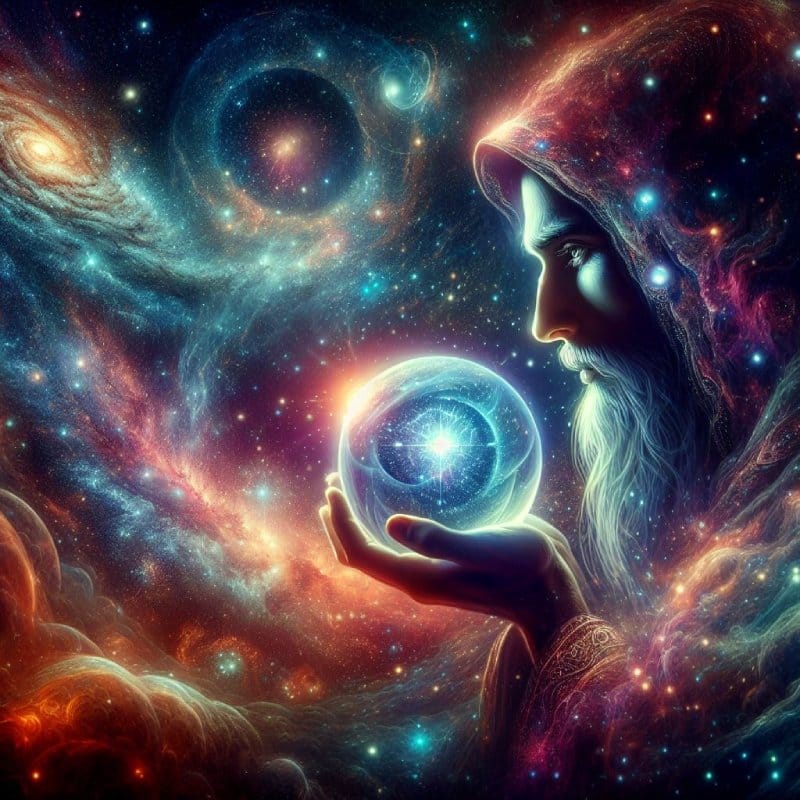Contents
To truly dive into the mysteries of Jewish mysticism and Kabbalah, one must almost live the experience – immerse oneself in it. Now, picture yourself centuries back, sifting through ancient scrolls and whispering chants in dimly lit rooms. Here, we merge timelines, intertwining Kabbalistic practices with the Hermetic traditions, painting a panorama of esoteric wisdom that transcends eras and cultures.

Mysticism in Judaism: The Esoteric Dance
At its core, Kabbalah isn’t merely a collection of mystical writings; it’s an invitation to personally encounter the Divine. By weaving through the labyrinthine pathways of Jewish spirituality, one stumbles upon a symphony of esoteric teachings and practices. And what’s fascinating is how Hermeticism sidesteps into this narrative – offering universal principles that feel like an echo, a resonance, with the mystical rhythms of Kabbalah.
The primal tradition of the one and only revelation has been preserved under the name of Kabbalah by the priesthood of Israel (1).
Historical Context and Development
Early Jewish Mysticism
Delving into the roots of Mysticism in Judaism, one must begin with texts like the Sefer Yetzirah and the Merkabah literature. These ancient scripts – wrapped in enigma and cryptic wisdom – lay the groundwork for what would blossom into Kabbalistic thought. Imagine sages poring over these texts, seeking to unravel the mysteries of the universe and the soul’s ascent.
According to this doctrine, the absolute is Being and therein is the Word which expresses the reason of Being and of life (2).
The Rise of Kabbalah
Fast forward to medieval times, and we see Kabbalah unfurling its wings. The Zohar emerges, a text of immense depth and breadth, painting vivid portraits of the divine realms and spiritual journeys. Kabbalistic ideas wove their way through Jewish communities, leaving an indelible mark on their spiritual landscape.
The Zohar: The central text of Kabbalah, offering commentary on the mystical aspects of the Torah and the nature of God, the universe, and the soul (3).
Integrating Hermetic Wisdom
As Mysticism in Judaism matured, it began to dialogue with other esoteric traditions, notably Hermeticism. With its emphasis on divine knowledge and cosmic unity, Hermeticism found a kindred spirit in Kabbalistic thought. This cross-pollination enriched Jewish mysticism, allowing it to absorb universal principles that further deepened its spiritual insights.
Core Practices and Beliefs
Pursuit of Divine Knowledge
The quest for divine knowledge – Daath – stands at the heart of Jewish mysticism. It’s an endless journey, a relentless pursuit of understanding God and the cosmos. Here, Hermetic principles step in, emphasizing the interconnectedness of the macrocosm and microcosm, thereby offering a broader canvas for Kabbalistic contemplation.
Inner Transformation
Transformation within is pivotal in Jewish mysticism. Ethical living, nurturing virtues like humility and compassion, forms the bedrock of this spiritual journey. Hermetic teachings echo this, urging a balance between the internal and external worlds, fostering moral and spiritual growth.
Meditative Practices
Meditation and contemplation are essential practices in Jewish mysticism. Techniques like devekut (clinging to God) and hitbodedut (solitary meditation) guide mystics towards divine connection. Hermeticism adds to this with its visualization techniques and contemplation of divine symbols, enriching the meditative experience.
A Harmonious Confluence
Thus, we witness a harmonious confluence – a blending of Kabbalistic and Hermetic traditions. This fusion transcends religious boundaries, offering profound spiritual insights that speak to the universal human quest for divine connection and inner transformation. So, as we navigate these mystical realms, let’s remember: it’s not just about the texts or practices, but the journey itself – a journey that invites us to constantly seek, reflect, and transform.
Influence and Legacy
Contributions to Spiritual Thought
Mysticism within Judaism has woven its intricate threads through the tapestry of Jewish culture, seeping into poetry, philosophy, and the arts. Jewish mystics, with their profound experiences, have enriched the spiritual heritage of Judaism. Let’s not forget Hermeticism; with its universal principles, it has also left an indelible mark—contributing to a shared esoteric tradition that transcends religious boundaries.
The Path of Unity
The shared mystical principles between Jewish mysticism and Hermeticism promote understanding and unity. Recognizing a common pursuit of divine knowledge and inner transformation fosters a sense of unity and mutual respect among different spiritual paths.
Contemporary Relevance
In today’s ever-evolving world, the teachings of Jewish mysticism and Hermeticism continue to inspire individuals seeking deeper spiritual meaning. Emphasizing personal experience, ethical living, and universal truths, they provide a timeless framework for spiritual growth and understanding in a modern context.
Jewish Kabbalah—distinctly different from Hermetic Kabbalah—intertwines deeply with religious interpretations and rabbinical laws. The focus often lies on the study of Torah and adherence to Jewish religious practices. Conversely, Hermetic Kabbalah offers an initiatory path emphasizing the direct experience of all levels of the Tree of Life (4). It serves as a channel for life power, aiming to benefit humanity by promoting spiritual growth and enlightenment. This esoteric tradition zeroes in on personal transformation and the practical application of mystical insights, free from religious dogma, thereby offering a more universal approach to understanding the mysteries of existence.
Conclusion
Mysticism in Judaism offers a profound pathway to divine and esoteric understanding. Exploring intersections with Hermeticism reveals how these traditions complement and enhance each other, offering a comprehensive approach to spiritual knowledge and inner transformation. While many Jewish Kabbalists remain attached to their religious interpretations, Hermeticism provides a universal system transcending these boundaries (5), allowing a deeper realization of Jewish mysticism and Kabbalah. For those interested in delving further into these mystical traditions, the Hermetic Academy offers resources and guidance on both mysticism, Kabbalah, and Hermeticism, fostering a deeper appreciation of their shared wisdom and practices.
FAQ- Mysticism in judaism
1. What is the focus of mysticism in Judaism?
A: Mysticism in Judaism aims for a direct, personal experience of the Divine, often achieved through practices like meditation, contemplation, and ethical living. It emphasizes inner transformation and spiritual knowledge.
2. How does Hermeticism relate to Jewish mysticism?
A: Hermeticism, with its universal principles of divine knowledge and cosmic unity, complements Jewish mysticism by offering additional insights and practices for spiritual growth. Both traditions pursue inner transformation and understanding of the divine.
3. What are common practices in Jewish mysticism?
A: Common practices include devekut (cleaving to God), hitbodedut (self-seclusion and meditation), and deep contemplation. These practices aim to cultivate a deep connection with the Divine and foster ethical and spiritual growth.
4. How has Jewish mysticism influenced spiritual thought?
A: Jewish mysticism has enriched spiritual thought through contributions in poetry, philosophy, and the arts. It has also promoted interfaith dialogue and unity by highlighting shared mystical principles with other traditions, such as Hermeticism.
5. Where can one learn more about mysticism and Hermeticism?
A: The Hermetic Academy offers resources and guidance for exploring these mystical traditions, providing a comprehensive approach to understanding and practicing mysticism, Kabbalah, and Hermetic principles.
References:
(1) Eliphas, L. (1854). Dogme et Rituel de la Haute Magie. Paris.
(2) Eliphas, L. (1854). Dogme et Rituel de la Haute Magie. Paris.
(3) Mathers, S. L. M. (1887). The Kabbalah Unveiled. London.
(4) Rubenstein, E. (2020). The Tree of Life: The Kabbalah of Immortality. Hermetic World, Paphos.
(5) Rubenstein, E. (2024) The Hermetic Experience: From Mystery to Self-Knowledge. Hermetic World, Paphos.





